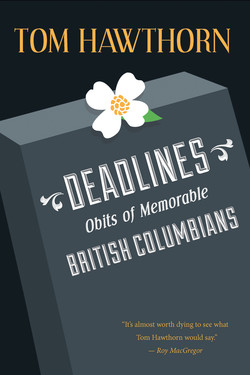Читать книгу Deadlines - Tom Hawthorn - Страница 24
На сайте Литреса книга снята с продажи.
ОглавлениеStan Brakhage
Avant-Garde Filmmaker
(January 14, 1933—March 9, 2003)
Stan Brakhage, a leading figure in experimental cinema often described as a poet who used film instead of words, was regarded as a genius by cineastes.
His avant-garde works never played at the cineplex, yet his exploration of the boundaries of camera technique and editing structure influenced such directors as Martin Scorsese, Francis Coppola and Lloyd Kaufman, creator of the cult fave The Toxic Avenger. David Fincher, the director of Seven, was among his students, as were Matt Stone and Trey Parker of South Park infamy, in whose Cannibal! The Musical he appeared.
Many of his original techniques and images have been stolen over the years by advertisers and Hollywood. A hand-held camera, multiple exposures and films edited with jarringly quick cuts were all part of a pioneering approach radical in its time.
Brakhage did not merely expose film to light; in his hands, film was scratched, painted, burned and bleached. Once, too destitute to afford film, he sandwiched bits of flowers and moth wings between strips of Mylar splicing tape.
Brakhage made more than four hundred films, one a mere nine seconds long, while another lasted a fidget-inducing four hours and twenty-one minutes. Most were made without sound, which he felt spoiled the intensity of the visual experience.
“How many colours are there in a field of grass to the crawling baby unaware of ‘Green?’” he asked in his 1963 book Metaphors on Vision. “How many rainbows can light create for the untutored eye? How aware of variations in heat waves can that eye be?”
His goal as a filmmaker was bold and presumptuous: “Imagine a world before the ‘beginning was the word.’”
A Brakhage film often lacked narrative, a deliberate choice, which made his work inscrutable to many. A decade after his first film, Interim, produced as a nineteen-year-old in 1952, the New York Times at last reviewed one of his works, Anticipation of the Night, four years after it had been completed. The melancholy meditation on suicide, for which he even contemplated committing his own, did not impress the critic Eugene Archer, who wrote: “It might better be called ‘Gleanings from the Cutting Room Floor.’”
Even those mainstream critics who admired his work were sometimes stretched for explanation. “There is beauty and serenity in Brakhage’s world of constantly changing colors and shapes,” Vincent Canby wrote in the Times in a 1975 review of The Text of Light. “Sometimes they fill the screen like volcanic eruptions; at other times they merely punctuate the black background, suggesting lazy, radioactive caterpillars looking for a rest.”
Brakhage created meditations on subjects as mundane as domestic life and as sacred as sexuality. Many of his pieces were autobiographical. In 1959, Brakhage graphically documented the birth of one of his children in Window Water Baby Moving, filmed before camcorders became standard delivery-room accessories. At the time, television portrayed married couples sleeping in separate beds.
His best-known work is Dog Star Man, a series of shorts combined into a seventy-four-minute film released in 1964. The mythic themes of the watershed film have been compared with the poetry of William Blake. Dog Star Man is regarded as one of the greatest pieces of American cinema, although its audience has been substantially smaller than that for, say, Titanic.
“He was a painter or poet in cinema,” said P. Adams Sitney, a film historian at Princeton University, “not a novelist like everybody else.”
Sitney confidently predicts the filmmaker someday will be regarded as the pre-eminent artist of the twentieth century.
Brakhage was born in an orphanage in Kansas City, Missouri, where he spent the first weeks of his life named Robert Sanders before being adopted by Ludwig and Clara Brakhage. They named the boy James Stanley.
He attended high school in Denver and performed on the radio as a boy soprano. After suffering a nervous breakdown as a freshman at Dartmouth College, he dropped out and took up filmmaking. He met and was influenced by such figures of the avant-garde as Maya Deren and Kenneth Anger. The personal films of Marie Menken had a great influence on him, as did Jean Cocteau, the Italian neo-realists, and the writings of Gertrude Stein.
In 1957, he married Jane Collom, with whom he collaborated, and he would take as his subject their life together, as well as that of their five children.
Brakhage was a noted educator in filmmaking, lecturing at the School of the Art Institute of Chicago from 1969 to 1981 and teaching at universities in Colorado for more than forty years. He was also a prolific writer, although many of his essays were too dense for all but the most dedicated film student.
After divorcing in 1987, Brakhage moved from Lump Gulch to Boulder, Colorado. He later began a relationship with Marilyn Jull, whom he married in Toronto in 1989. They lived there for eight months, returning to Colorado only after he was unable to secure a suitable position at one of the universities in Ontario.
Among his many awards were Rockefeller and Guggenheim fellowships and, in 1986, the inaugural Maya Deren Award for independent film and video artists from the American Film Institute. When Brakhage became the first filmmaker to receive the prestigious Edward MacDowell medal in 1989, Scorsese presented the award in a ceremony at Peterborough, New Hampshire.
In 2002, Brakhage moved to Victoria, his wife’s hometown, where he lived six months before dying of cancer. Though bedridden, Brakhage continued filming through the final days of his illness. He completed Stan’s Window, which was filmed chiefly through the windows and doors of his sick room. He also scratched emulsion with his fingernail in his final work, titled The Chinese Series. Inspired by Chinese language and thought, it was incomplete at his death.
March 13, 2003
